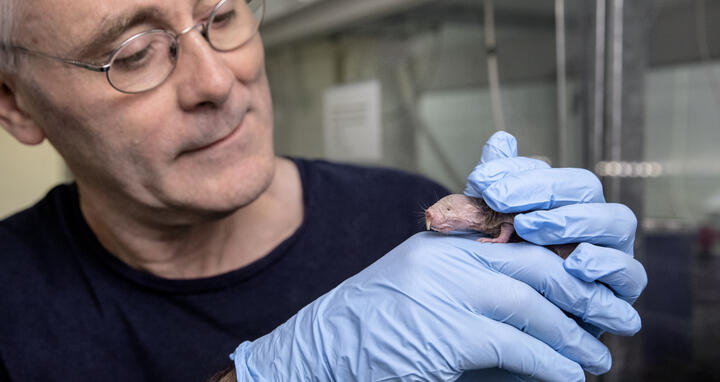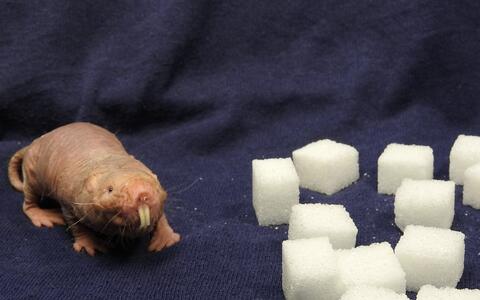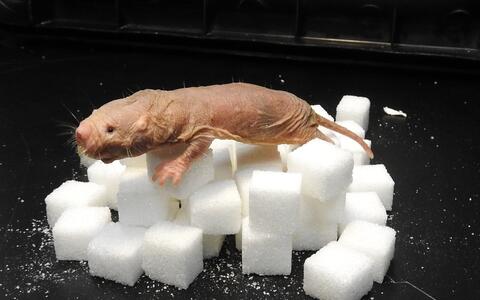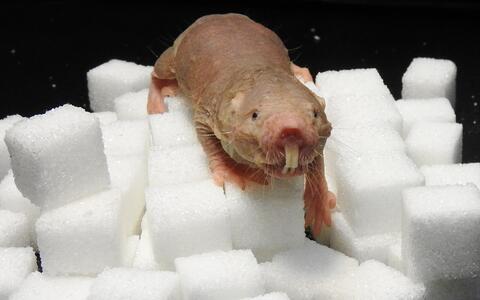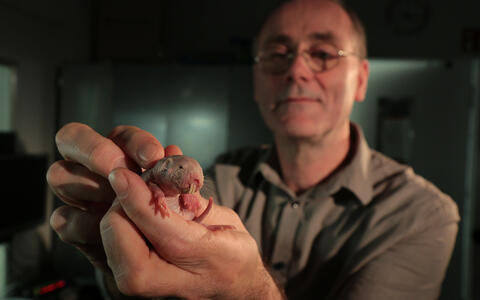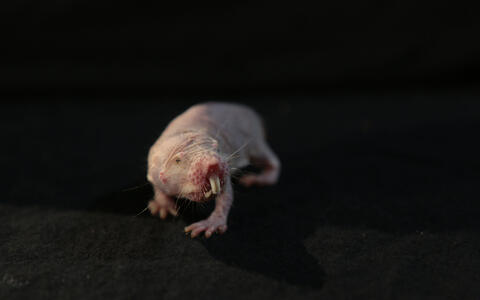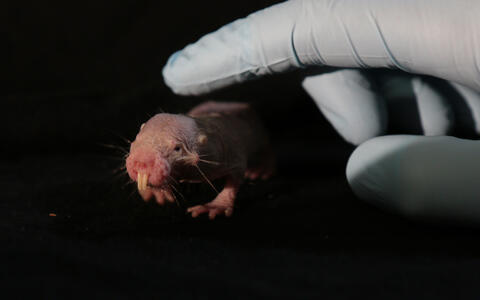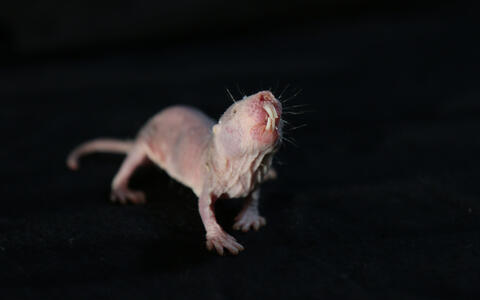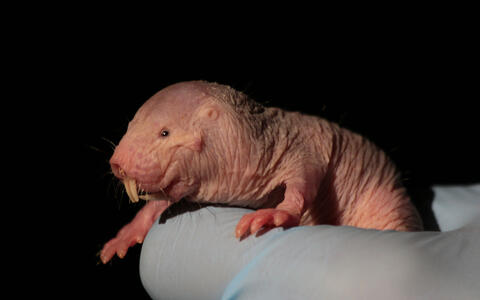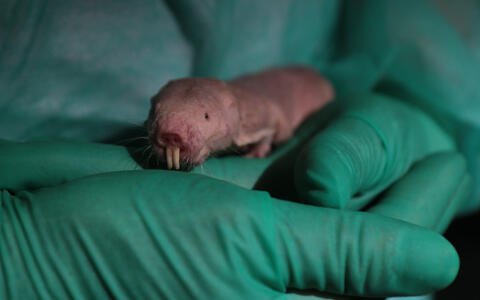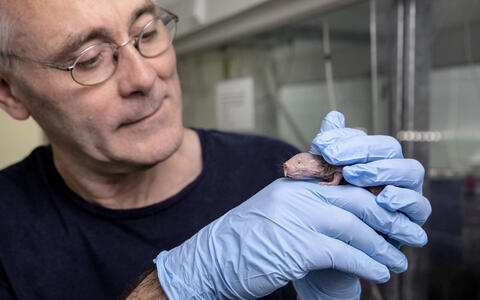Touch, pain and the strange sensory world of the naked mole rat
There’s a remarkable connection between this strange animal and my work.
The animal looks rather inconspicuous at first sight. In Gary Lewin’s workroom at the Max Delbrück Center, there is a small charcoal drawing on the left wall depicting a naked mole rat with small eyes and prominent teeth. “There’s a remarkable connection between this strange animal and my work,” says Lewin. For the African naked mole rat (Heterocephalus glaber) is largely insensitive to pain, which is why it initially aroused Lewin’s interest.
In the beginning there was pain
Lewin was born in 1965 on the Isle of Man. The neurophysiologist has been conducting research at the Berlin-based MDC since 1996. He had already made an important discovery before joining the Center. As a postdoctoral fellow at Stony Brook University in New York (SUNY), Lewin deciphered the biochemical role of a signaling molecule called NGF (nerve growth factor) in the perception of pain. “NGF is a protein that allows new nerve cells to develop, particularly during the embryonic stage,” explains the researcher. It is also released when nerve pathways become inflamed or injured. In the laboratory, Lewin was able to develop an antibody against NGF, thereby suppressing inflammatory pain in mice. This discovery is important for pain therapy, as NGF also controls the perception of pain in humans. Clinical studies are currently underway on an NGF drug for the treatment of osteoarthritis. Final approval is still pending. Lewin concludes: “It can easily take a decade and a half between the research results in the lab and clinical applications to treat patients.”
Lewin not only needs patience in his work, he also seeks inspiration. Lewin, wearing metal-rimmed glasses of the kind usually worn by students, has an alert, curious expression. Leaning back in his blue swivel chair, he recalls something from his PhD days. In London, he normally joined colleagues in the pub after work on Fridays, and Patrick Wall was frequently part of the group. The neurophysiologist, a man of great reputation, had already retired. Together with the psychologist Ronald Melzack, Wall had developed the gate control theory, which explains the body’s own pain suppression system. According to this theory, not every pain impulse arrives in the brain, as it first has to cross a “gate” in the spinal cord. “Wall was incredibly well read, and not only in the natural sciences, but also in literature. A very intellectual type,” enthuses Lewin. Wall was also a gifted methodologist. “Science isn’t just about experimenting right away. It’s an intellectual challenge,” says Lewin, recalling conversations in the pub. Good science relies on smart research design. And this is something Lewin is still enthusiastic about to this day.
Gary Lewin
Hope for a cure for neuropathic pain
He made his second major discovery at the MDC through another experience related to pain. “Our sense of touch had been researched very little up to that point,” says Lewin. His original question was, “How does the nervous system interpret mechanical pressure on the skin as an electrical impulse?” The answer: there are nerve endings everywhere in the skin that are able to convert a stimulus into an electrical impulse. “But the actual mechanism was unknown for a long time,” adds Lewin. His hypothesis was that the stimulation takes place mechanically via ion channels, pore-like valves in the nerve membrane through which electrically charged particles can pass. This was shown in nematode worms by another research group. In 2007, working with mice, Lewin and his team at the MDC succeeded in deciphering the ion channel’s mechanism of action and later switching it off. The mice became less sensitive to touch. “For the first time ever in a mammal,” notes the researcher.
Gary Lewin
The significance is enormous. Many people suffer from neuropathic pain. Due to nerve injury or diabetes, they perceive a small touch to the skin as stabbing pain. Lewin’s team discovered a biochemical way to eliminate pain. STOML3 is the name of the stomatin-like protein that controls the ion channels in the cell membrane, and thus the flow of stimuli. In 2017, Lewin’s team succeeded in finding a molecule that inhibits STOML3 and with it, a portion of the skin’s mechanoreceptors. “This works like a local anesthetic,” explains Lewin.
“House of Targaryen” in the basement
The man wants to alleviate pain. The naked mole rat helps him in this endeavor. Lewin’s naked mole rat colony lives one floor below his office, behind an inconspicuous door. The rodent continually amazes the researcher. “The naked mole rat is the only laboratory animal we know that is socially adept,” says Lewin. Although it’s not as social as all that. If an animal from another colony happens to stray upon a group, it will be bitten to death. There is a strict hierarchy among naked mole rats. They live in matriarchies, which is probably why Lewin and his team associate them with the TV series “Game of Thrones,” calling the lab colony the “House of Targaryen.” This is inscribed on the plastic cylinder which replaces the East African underground burrows the animal normally lives in.
Lewin discovered the naked mole rat more or less by chance. A friend, the American researcher Thomas Park, had discovered that the skin of the naked mole rat does not react to capsaicin, the burning irritant found in chili peppers. Summer after summer, Park transported a few animals from Chicago to Berlin for his friend. In this way, Lewin was able to build up his own colony. And he learned a great deal – about the rodents, pain, and the whims of nature. “Over millions of years, the animals have simply cast away everything underground which uses their energy and isn’t necessary to survive. This includes their fur,” says Lewin. The animals do what Lewin has devoted years of research to: They simply switch off the pain.
“The naked mole rat never ceases to surprise us”
Evolution found this mechanism 30 million years before us. And now we want to use the same system to treat patients.
Lewin’s team analyzed the biochemical mechanism involved and determined that the pain receptor TrkA, which transmits the stimulus into the cell in mammals, is slightly modified in the naked mole rat. The NGF molecule, which Lewin has studied for nearly three decades, is therefore unable to trigger a stimulus. This makes the naked mole rat resistant to pain. Lewin: “It’s impressive. Evolution found this mechanism 30 million years before us. And now we want to use the same system to treat patients.”
But the pain researcher’s story doesn’t end here. After all, Lewin is a scientist. He is driven by the quest for new knowledge. The naked mole rat does not suffer from cancer, it becomes extremely old, and can live for a long time without oxygen. “The animal never ceases to surprise us,” says Lewin. His team now also includes behavioral researchers. “The naked mole rat has its own vowel system, which encompasses 20 sounds. It chirps,” says Lewin. The researchers are also investigating the animals’ language. Initial results have already been obtained.
Meanwhile, Lewin has accumulated 300 naked mole rats that will soon move into a larger laboratory. Their numbers are set to grow to a thousand. The MDC would then house the world’s second-largest lab colony of naked mole rats after Google. There, researchers are trying to decipher the mystery of the rodents’ old age. And Lewin? He says he’s too old “to delve into research on aging.” This is a joke, of course, because the researcher remains curious: “Experiments are what make science exciting.”
Text: Peter Riesbeck

